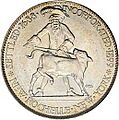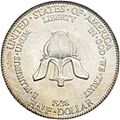New Rochelle 250th Anniversary half dollar facts for kids
| United States | |
| Value | 50 cents (0.50 US dollars) |
|---|---|
| Mass | 12.5 g |
| Diameter | 30.61 mm (1.20 in) |
| Thickness | 2.15 mm (0.08 in) |
| Edge | Reeded |
| Composition |
|
| Silver | 0.36169 troy oz |
| Years of minting | 1937 (dated 1938) |
| Mintage | 25,015 including 15 pieces for the Assay Commission (9,749 melted) |
| Mint marks | None, all pieces struck at the Philadelphia Mint without mint mark |
| Obverse | |
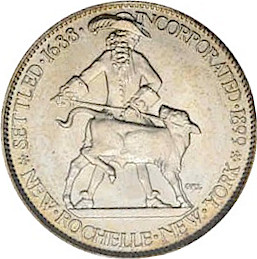 |
|
| Design | John Pell and "Fatt Calfe" |
| Designer | Gertrude K. Lathrop |
| Design date | 1937 |
| Reverse | |
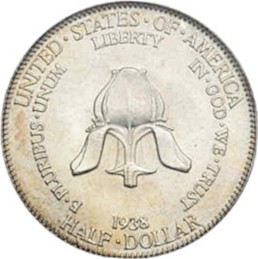 |
|
| Design | Fleur de lis |
| Designer | Gertrude K. Lathrop |
| Design date | 1937 |
The New Rochelle 250th Anniversary half dollar is a special commemorative coin made by the U.S. Mint. It was created to celebrate the 250th birthday of New Rochelle, New York, a city in Westchester County.
A talented artist named Gertrude K. Lathrop designed this coin. She was chosen after another artist's ideas were not approved. The coin shows John Pell leading a "fatted calf" on one side. Pell was the person who sold the land where New Rochelle was built. The other side of the coin features a fleur-de-lis. This symbol is part of New Rochelle's city seal and comes from La Rochelle, a city in France that New Rochelle is named after.
Even though the coin says "1938" on it, it was actually made in 1937. The New Rochelle half dollar was the last new commemorative coin design made by the U.S. Mint for several years, until 1946.
Coin collectors in Westchester County wanted a special coin for the New Rochelle anniversary. They got help from members of the U.S. Congress, who passed a law for the coin in 1936. After the first artist's designs were rejected, Gertrude Lathrop was hired. She decided to show the "fatted calf" because of a unique agreement. John Pell was supposed to receive a fatted calf every year, or the land would go back to him! Lathrop's design was approved, and the coins were made at the Philadelphia Mint in 1937.
A special committee in New Rochelle sold the coins for $2 each. They sold them locally and by mail to people all over the United States and even other countries. When sales slowed down, nearly 10,000 coins were sent back to the Mint to be melted. Today, these coins are worth much more, often selling for hundreds of dollars.
Contents
New Rochelle's History
The city of New Rochelle, New York, was started by a group of French Protestants called Huguenots in 1688. They came from a city in France called La Rochelle. The next year, a man named Jacob Leisler bought a large piece of land, about 6,000 acres, from John Pell. This is the land where New Rochelle stands today.
One interesting part of the land deal was a special condition. Every year on June 24, if John Pell or his family asked for it, they were supposed to receive "one fatt calfe." If the calf wasn't given, the land could be taken back! Later, a famous writer named Thomas Paine owned land in New Rochelle. The area became a village in 1858 and a city in 1899. Today, it's a busy suburb of New York City.
Why Make a Commemorative Coin?
In the 1930s, many special United States commemorative coins were being made. The U.S. government would sell these coins at their face value to a group chosen by Congress. This group would then sell the coins to the public for a higher price, making a profit. This money was often used to fund special events or projects.
In 1936, the market for these commemorative coins became very popular. Many people started coin collecting because they saw a chance to make money. Congress approved many new commemorative coins that year. To prevent problems, new rules were added to coin bills. For example, all coins for a specific event had to be made at only one mint. Also, all the coins had to have the same date.
The idea for the New Rochelle coin came from the Westchester County Coin Club. They wanted to help pay for the city's 250th anniversary celebrations. This way, the money wouldn't have to come from taxpayers, who were struggling during the Great Depression.
How the Coin Law Was Passed
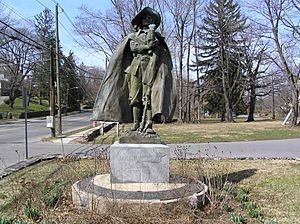
Bills to create a New Rochelle half dollar were introduced in Congress in January 1936. Senator Royal S. Copeland and Representative Charles D. Millard, both from New York, helped with this. The House of Representatives approved their bill in March 1936.
However, some senators were concerned about how commemorative coins were being handled. Some issues had different dates or were sold by only a few dealers, making it hard for collectors to get them. To fix this, the Senate changed the New Rochelle bill. They added rules that all the coins must have the same date and be made at one mint. They also said that at least 5,000 coins had to be released at a time.
The House and Senate worked together to agree on the final version of the bill. On May 5, 1936, President Franklin D. Roosevelt signed the bill into law. This meant the New Rochelle half dollar could be made!
Designing the New Rochelle Coin
The New Rochelle Commemorative Coin Committee was formed to manage the coin project. They first hired an artist named Lorrilard Wise. His designs showed a Native American on one side and New Rochelle's coat of arms on the other. However, the Commission of Fine Arts (CFA), a group that advises on public artworks like coins, had concerns about these designs. They suggested the main side of the coin be completely redone.
After more attempts, the CFA asked the committee to find a new artist. In late 1936, the committee saw the Albany Charter half dollar, which was designed by Gertrude K. Lathrop. They were very impressed and hired her. Lathrop spent a lot of time in New Rochelle to get ideas. She and the committee decided on the "fatted calf" for the front (obverse) of the coin. For the back (reverse), they chose the fleur-de-lis, a symbol from New Rochelle's city shield.
Lathrop even talked to President Roosevelt, who she knew from his time as Governor of New York, to get support for her designs. On February 18, 1937, the CFA finally approved both of her designs. The U.S. Treasury Department then received money to make the coin dies and to pay for the half dollars.
What the Coin Looks Like
The front, or obverse, of the New Rochelle half dollar shows a "fatted calf" being held by a man. This man is meant to be John Pell. Gertrude Lathrop studied paintings of Pell's family to make his likeness accurate. The model for the calf was a real Guernsey calf from a farm in New York. Lathrop said the calf was a bit wild at first, but it got used to her and would even "kiss" her nose! She wanted the calf design to be a bit humorous but still look dignified and beautiful.
Around the edge of the front of the coin, you can read "NEW•ROCHELLE•NEW•YORK" and "SETTLED•1688•INCORPORATED•1899". Lathrop's initials, "GKL", are near the calf's front legs.
The back, or reverse, of the coin features a fleur-de-lis. This symbol is part of New Rochelle's city seal and comes from the city of La Rochelle in France. Around the edge of the back, you'll see "UNITED•STATES•OF•AMERICA, E•PLURIBUS•UNUM, LIBERTY" and "IN• GOD•WE•TRUST". The date "1938" and the value "HALF•DOLLAR" are at the bottom.
The New Rochelle half dollar is special because it was the last U.S. coin to have small tooth-like bumps, called denticles, along its rim. These had been removed from regular circulating coins. It was also the last new commemorative coin design until 1946.
Some coin experts have praised Lathrop's design, calling it one of the most attractive commemorative coins. They liked how she arranged all the required words on the coin without making it look crowded. However, other experts have criticized the design, calling it "tasteless."
Selling and Collecting the Coin
In April 1937, 25,015 New Rochelle half dollars were made at the Philadelphia Mint. A small number, 15 coins, were set aside for testing later. The coins were sent to a bank in New Rochelle, where the coin committee and the Skipton family processed mail orders. Locals could also buy coins directly from the bank. They sold for $2 each, plus shipping.
The very first coin made was given to the mayor of New Rochelle. The second went to the president of the Westchester County Coin Club. The committee received orders from all 48 states, and even from places like Canada and New Zealand!
However, by 1937, there were too many different commemorative coins being released, and the market for them slowed down. Sales of the New Rochelle half dollar stopped after about half of them were sold. Because of this, 9,749 coins were sent back to the Philadelphia Mint in 1938 to be melted down. This means only about 15,266 coins still exist today. The money earned from selling the coins helped pay for New Rochelle's 250th anniversary celebrations in June 1938.
A few special "proof" coins were also made. These were struck on polished coin blanks and given to important people.
Over the years, the value of the New Rochelle half dollar has increased a lot. In 1940, it sold for $1.75. By 1985, it was worth $500. Today, depending on its condition, it can sell for hundreds of dollars. Some exceptional coins have sold for thousands!
The tradition of giving a fatted calf to the Pell family became less formal after the American Revolution. However, the gift has been made from time to time, such as for the 250th anniversary in 1938 and the 300th in 1988. At the 300th anniversary, a U.S. Senator named Claiborne Pell was there to represent the family. The calf at that event was a bit stubborn and had to be dragged onto the stage!
Images for kids


